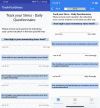Exploring the Time Trend of Stress Levels While Using the Crowdsensing Mobile Health Platform, TrackYourStress, and the Influence of Perceived Stress Reactivity: Ecological Momentary Assessment Pilot Study
- PMID: 31670692
- PMCID: PMC6913730
- DOI: 10.2196/13978
Exploring the Time Trend of Stress Levels While Using the Crowdsensing Mobile Health Platform, TrackYourStress, and the Influence of Perceived Stress Reactivity: Ecological Momentary Assessment Pilot Study
Abstract
Background: The mobile phone app, TrackYourStress (TYS), is a new crowdsensing mobile health platform for ecological momentary assessments of perceived stress levels.
Objective: In this pilot study, we aimed to investigate the time trend of stress levels while using TYS for the entire population being studied and whether the individuals' perceived stress reactivity moderates stress level changes while using TYS.
Methods: Using TYS, stress levels were measured repeatedly with the 4-item version of the Perceived Stress Scale (PSS-4), and perceived stress reactivity was measured once with the Perceived Stress Reactivity Scale (PSRS). A total of 78 nonclinical participants, who provided 1 PSRS assessment and at least 4 repeated PSS-4 measurements, were included in this pilot study. Linear multilevel models were used to analyze the time trend of stress levels and interactions with perceived stress reactivity.
Results: Across the whole sample, stress levels did not change while using TYS (P=.83). Except for one subscale of the PSRS, interindividual differences in perceived stress reactivity did not influence the trajectories of stress levels. However, participants with higher scores on the PSRS subscale reactivity to failure showed a stronger increase of stress levels while using TYS than participants with lower scores (P=.04).
Conclusions: TYS tracks the stress levels in daily life, and most of the results showed that stress levels do not change while using TYS. Controlled trials are necessary to evaluate whether it is specifically TYS or any other influence that worsens the stress levels of participants with higher reactivity to failure.
Keywords: crowdsensing; ecological momentary assessment; mHealth; pilot study; psychological stress.
©Rüdiger Pryss, Dennis John, Winfried Schlee, Wolff Schlotz, Johannes Schobel, Robin Kraft, Myra Spiliopoulou, Berthold Langguth, Manfred Reichert, Teresa O'Rourke, Henning Peters, Christoph Pieh, Claas Lahmann, Thomas Probst. Originally published in JMIR Mhealth and Uhealth (http://mhealth.jmir.org), 30.10.2019.
Conflict of interest statement
Conflicts of Interest: None declared.
Figures



References
-
- Lazarus RS, Folkman S. Stress, Appraisal, and Coping. New York: Springer Publishing Company; 1984.
-
- Schneiderman N, Ironson G, Siegel SD. Stress and health: psychological, behavioral, and biological determinants. Annu Rev Clin Psychol. 2005;1:607–28. doi: 10.1146/annurev.clinpsy.1.102803.144141. http://europepmc.org/abstract/MED/17716101 - DOI - PMC - PubMed
MeSH terms
LinkOut - more resources
Full Text Sources
Medical

